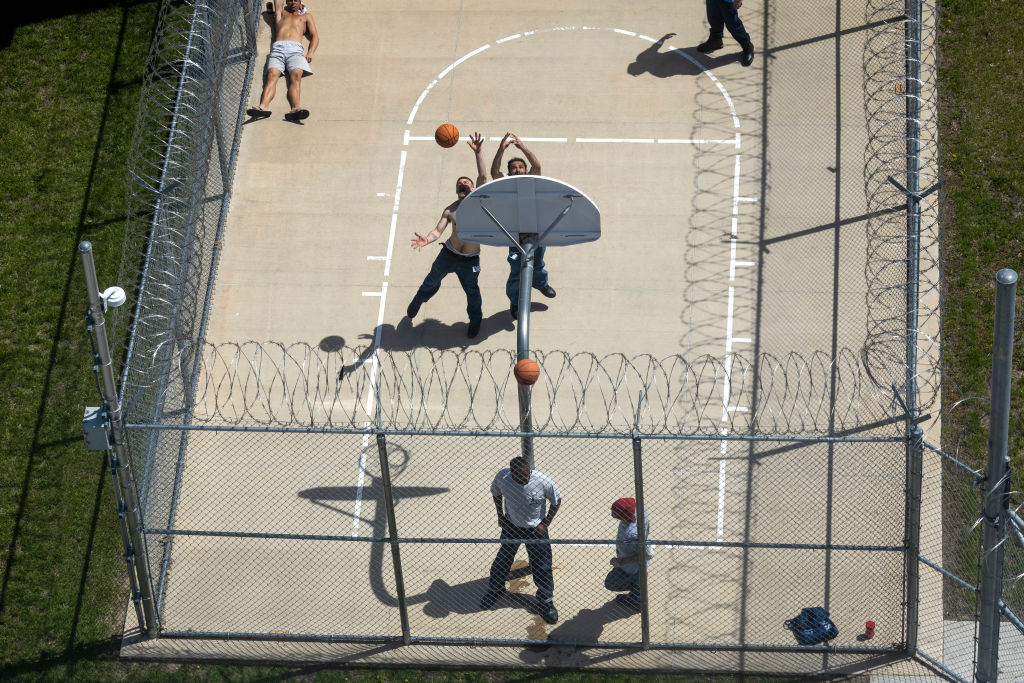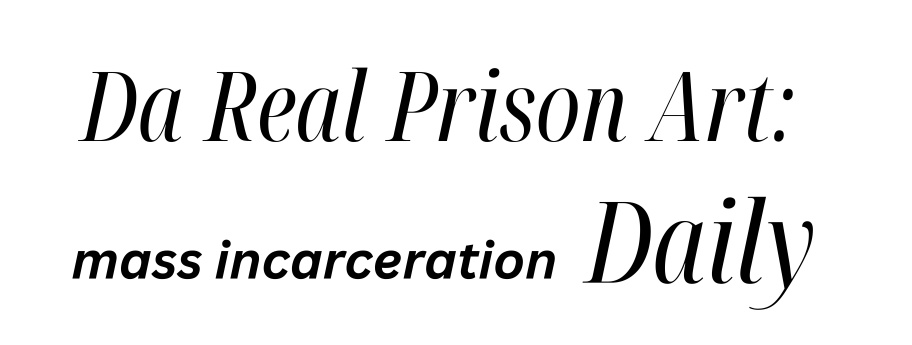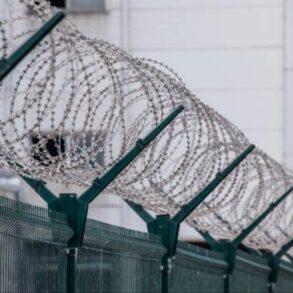
Across the United States, state prison systems are grappling with chronic understaffing and overcrowding — dual crises that are keeping incarcerated people confined to their cells for far longer periods than in recent decades.
Lockdowns are common in jails and prisons nationwide, but most usually last only a few hours or days. During lockdowns, access to rehabilitative classes, religious activities, work and visitation is limited or completely suspended. Incarcerated people on lockdown can lose their usual routines, which may include exercise, calls to loved ones and other structured activities. And meals are typically eaten inside the prisoner’s cell, further isolating them.
Recently, lockdowns have been extended for weeks or even months at many facilities suffering staff shortages.
“What’s unusual here is that you’ve got these more sustained lockdowns,” Michele Deitch, the director of the Prison and Jail Innovation Lab at the University of Texas at Austin, told Stateline. “People are not in that situation because of disciplinary reasons. They’re in there for the convenience and management of the institution.”
Prisons in many states have implemented prolonged lockdowns. In some cases they have intensified tensions within prison walls, at times contributing to violence between incarcerated people and staff, increased drug use and deaths by suicide.
For example, the Green Bay Correctional Institution in Wisconsin resumed normal operations in July after being on lockdown for more than a year. As of Nov. 29, the facility housed 1,080 people, nearly 45% above its designed capacity of 749.
Meanwhile, the Waupun Correctional Institution, also in Wisconsin, has been under some form of lockdown for more than a year. At least five incarcerated people have died since June 2023. Nine current and former staff members, including the facility’s previous warden, are facing felony charges in connection with two of the deaths.
The facility has resumed normal operations “for the most part since this summer when in-person visitation resumed,” wrote Beth Hardtke, the Wisconsin Department of Correction’s director of communications, in an email to Stateline.
As of mid-November, the vacancy rate for corrections officers and sergeants across the state’s adult correctional facilities was nearly 12%, down significantly from the peak of 35% in August of last year, according to the department’s staffing dashboard. In the state’s juvenile facilities, the vacancy rate stands at about 10%.
“The past months of modified movement have allowed staff to examine our policies to enhance safety while offering persons in our care high-quality educational and therapeutic programming and services,” said Wisconsin Department of Corrections Secretary Jared Hoy in a June news release.
The South Dakota Department of Corrections in October ended a 17-day lockdown of nearly 1,300 people at the state penitentiary in Sioux Falls. During the lockdown, corrections officers discovered contraband, including handmade weapons and unauthorized electronics.
Tennessee has fined private prison operator CoreCivic $29.5 million for failing to meet staffing requirements in four facilities since 2022.
In Texas, some facilities operate with a 70% corrections officer vacancy rate — meaning those prisons are trying to maintain security with fewer than half the officers they need, according to a September report from the Sunset Advisory Commission, a legislative agency tasked with evaluating state departments. The evaluation came in the wake of a statewide prison lockdown that lasted just over a month last year, prompted by a rise in contraband and drug-related homicides among inmates.
Lockdowns are one of those things that just fly under the radar.
– Michele Deitch, director of the Prison and Jail Innovation Lab
The report highlighted that the state’s incarcerated population is projected to outgrow the Texas Department of Criminal Justice’s bed capacity by the end of fiscal year 2025.
And a federal investigation into Georgia’s state prison system found conditions that violate the U.S. Constitution, including rampant violence, sexual assault, drug smuggling and gang activity, according to a report released in October by the U.S. Department of Justice.
The report also revealed that sexual violence remains prevalent in isolation areas, and that the Georgia Department of Corrections places some people in lockdown with others who sexually abuse them.
An investigation by the nonprofit news outlet Truthout found that at least 33 state prison systems had placed incarcerated adults under non-disciplinary lockdowns at least once — and often repeatedly or for extended periods — between 2016 and 2023.
Despite the many extended lockdowns and mounting pressure to fill vacancies and manage growing prison populations, most states neither report nor are legally required to disclose the frequency of lockdowns or what types of incidents occur during them, according to some prison policy experts.
“Lockdowns are one of those things that just fly under the radar,” Deitch, of the Prison and Jail Innovation Lab, told Stateline. “We’re underestimating the number of people that are affected by these kinds of policies.”
Rising tensions and dire consequences
The long-standing issues of understaffing and overcrowding in U.S. prisons were brought into sharper focus during the COVID-19 pandemic, when widespread lockdown restrictions and severe staffing shortages further strained correctional facilities.
These shortages extend beyond corrections officers, affecting prison health care staff and other essential personnel.
In 2021, one incarcerated Missouri man who was in severe pain pulled out his own teeth after he was unable to secure a dental appointment due to staffing shortages, according to the Jefferson City News Tribune.
These extended lockdowns have become increasingly similar to restrictive housing, or solitary confinement, which is when incarcerated people are confined to their cells for up to 24 hours a day with minimal human contact or access to activities, according to Deitch.
“You’re going to see a lot more tension rising among the population, which could lead to more assaults and other kinds of abuses. You’re more likely to see people using drugs or something to kind of escape from all of that,” Deitch said.
In September, an incarcerated person attacked two prison staff members at the Iowa State Penitentiary. Union leaders said the staff assault was symptomatic of the agency’s understaffing; it was the 33rd such attack of the year at the prison.
In Illinois, employees from more than 24 state correctional facilities rallied in October to protest unsafe working conditions. Officers reported a rise in violent assaults on staff and exposure to narcotics, synthetic drugs and other toxic substances. As of Dec. 2, at least four state correctional facilities, all of which experienced officer protests, are under either partial or full lockdown.
The Illinois Department of Corrections’ operation and management reports show a major uptick in the number of lockdowns across facilities, with 635 in fiscal year 2019 and 1,814 in fiscal year 2024.
The strain on workers
Across the country, corrections staff are frequently required to work mandatory overtime because of severe staffing shortages.
These extra hours leave little time for officers to rest, spend time with their families or manage personal responsibilities, making it difficult to maintain a healthy work-life balance, according to Andy Potter, a former corrections officer and the founder of One Voice United, a national advocacy group representing corrections staff.
The demanding schedules also can take a significant toll on staff’s physical and mental health, leading to burnout and further exacerbating the staffing crisis, as some officers leave the profession entirely. This cycle creates an even greater strain on the remaining staff, perpetuating a system stretched beyond its limits.
State prison populations also grew by 2% between 2021 and 2022, according to the most recent data from the federal Bureau of Justice Statistics, reversing a longtime downward trend.
The growth could continue: Several states recently have enacted laws aimed at cracking down on violent crimes, drug-related crimes, retail theft and other crimes that could send more people to prison. The states include Arizona, California, Colorado, Georgia, Louisiana, Oregon and Tennessee.
Yet prisons across the country have long struggled to recruit and retain staff. In 2023, the number of people working in state prisons fell to its lowest level this century, according to the latest data from the U.S. Census Bureau.
Some states have tried to address prison understaffing by raising starting wages and offering comprehensive benefits packages. But the strategies that attract new hires won’t retain them if mandatory overtime and poor working conditions continue, say worker advocates.
“There’s a real blind spot when it comes to how employees are treated, how they are trained, how they are looked at in this paramilitary structure,” said Potter, who worked as a Michigan state corrections officer for more than 20 years.
“I don’t think you’ll ever see a level of success from locking down a prison,” he said, “other than you have to be able to maintain the security and the safety of those that are in your custody and those that are in your employment.”
Stateline is part of States Newsroom, a nonprofit news network supported by grants and a coalition of donors as a 501c(3) public charity. Stateline maintains editorial independence. Contact Editor Scott S. Greenberger for questions: [email protected]. Follow Stateline on Facebook and X.
YOU MAKE OUR WORK POSSIBLE.
This post was originally published on this site be sure to check out more of their content.








